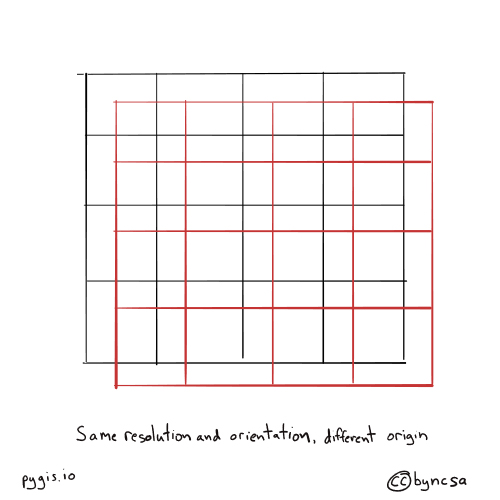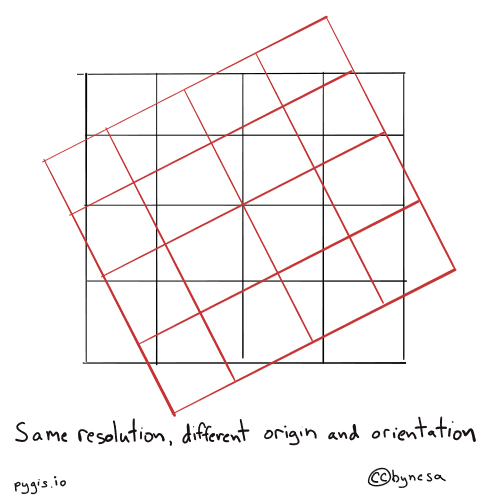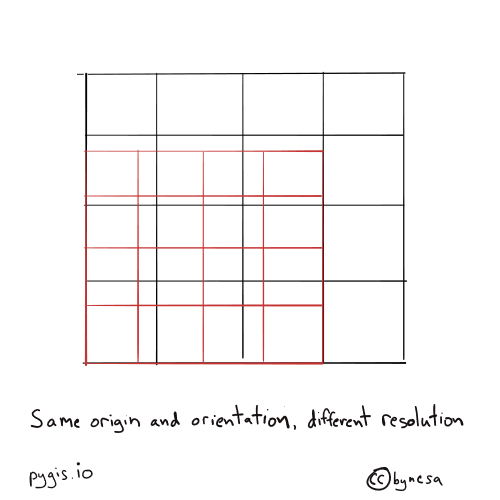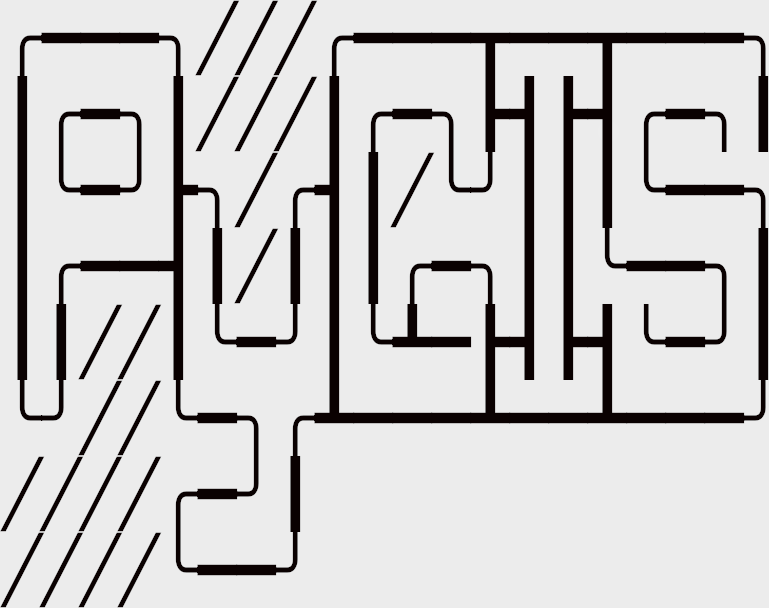Learning Objectives
Resample a raster with rasterio & geowombat
Learn how to match the extent
Review
Resampling & Registering Rasters w. Rasterio and Geowombat#
Why is Resampling Important?#
Before you begin any analysis using rater data it is critical that you have rasters that are “co-registered”. Co-registration requires that any two rasters have the same resolution, and orientation - the origins can differ but they much align. In other words, co-registration requires that cell centroids align perfectly for all intersecting areas. Resampling is also extremely common during reprojection operations as it often requires changing the orientation, scale or resolution of an image.
Examples of data that is not co-registered

Fig. 68 Resampling rasters - different orientation#

Fig. 69 Resampling rasters - different orientation and origin#

Fig. 70 Resampling rasters - different resolution#
We can co-register images by resampling, and often reprojecting, one image to match another.
Methods for Resampling Explained#
There are a number of methods to resample data, but they often take the form of “nearest neighbor”, “bilinear”, and “cubic convolusion” - these interpolation methods are explained here in some detail. But there are a number of other including: [‘average’, ‘cubic_spline’, ‘gauss’, ‘lanczos’, ‘max’, ‘med’, ‘min’, ‘mode’, ‘nearest’].
resampling direction
Upsampling - converting to higher resolution/smaller cells.
Downsampling - converting to lower resolution/larger cell sizes.
Simple Up/Downsampling in Rasterio & Geowombat#
Rasterio Upsampling Example#
Occationally you will need to resample your data by some factor, for instance you might want data upsampled to a courser resolution due to memory constraints.
Here’s an example of how to generate the data array and the transform needed to write it out. We will start by simply reading in the data and coersing a higher resolution, by adding more rows and columns. To understand the transform, let’s review affine transformations. Here we will update the scale values with the new resolution using \(S_{y}\) and \(S_{x}\) show below
import rasterio
from rasterio.enums import Resampling
image = "../data/LC08_L1TP_224078_20200518_20200518_01_RT.TIF"
upscale_factor = 2
with rasterio.open(image) as dataset:
# resample data to target shape using upscale_factor
data = dataset.read(
out_shape=(
dataset.count,
int(dataset.height * upscale_factor),
int(dataset.width * upscale_factor)
),
resampling=Resampling.bilinear
)
print('Shape before resample:', dataset.shape)
print('Shape after resample:', data.shape[1:])
# scale image transform
dst_transform = dataset.transform * dataset.transform.scale(
(dataset.width / data.shape[-1]),
(dataset.height / data.shape[-2])
)
print('Transform before resample:\n', dataset.transform, '\n')
print('Transform after resample:\n', dst_transform)
## Write outputs
# set properties for output
# dst_kwargs = src.meta.copy()
# dst_kwargs.update(
# {
# "crs": dst_crs,
# "transform": dst_transform,
# "width": data.shape[-1],
# "height": data.shape[-2],
# "nodata": 0,
# }
# )
# with rasterio.open("../temp/LC08_20200518_15m.tif", "w", **dst_kwargs) as dst:
# # iterate through bands
# for i in range(data.shape[0]):
# dst.write(data[i].astype(rasterio.uint32), i+1)
Reminder
Read up on affine transformations to help you understand the transform.scale function above.
Geowombat Up/Down Sampling Example#
As always the easiest way to deal with resampling is by deploying geowombat. It’s like a swiss army knife for kicking raster butt. Here we just need to set the desired resolution with ref_res, and the resampling method in the open statement. We have a number of resampling methods available depending on the context listed above. Writing a file is a bit more intuitive too.
import geowombat as gw
image = "../data/LC08_L1TP_224078_20200518_20200518_01_RT.TIF"
with gw.config.update(ref_res=15):
with gw.open(image, resampling="bilinear") as src:
print(src)
# to write out simply:
# src.gw.to_raster(
# "../temp/LC08_20200518_15m.tif",
# overwrite=True,
# )
Much…. easier….
Co-registering Rasters (Aligning cells)#
One common problem is how to get raster data to align on a cell by cell basis so you can complete your analysis. We will walk through how to do this for both rasterio and geowombat. In the following example we will learn how to align rasters with different origins, resolutions, or orientations.
Our example data will look at registering LandSat data with precipitation data from CHIRPS.
Example of Co-registering Rasters with Rasterio#
Co-registering data is a bit complicated with rasterio, you simply need to choose an “reference image” to match the bounds, CRS, and cell size.
The original input data LandSat data is 30 meters and will be downsampled to match precip which is 500m. Also note the use of nodata to avoid missing values stored as 0. Note we can choose a number of resampling techniques listed above. For more detail on resampling go to Introduction to Raster CRS.
from rasterio.warp import reproject, Resampling, calculate_default_transform
import rasterio
def reproj_match(infile, match, outfile):
"""Reproject a file to match the shape and projection of existing raster.
Parameters
----------
infile : (string) path to input file to reproject
match : (string) path to raster with desired shape and projection
outfile : (string) path to output file tif
"""
# open input
with rasterio.open(infile) as src:
src_transform = src.transform
# open input to match
with rasterio.open(match) as match:
dst_crs = match.crs
# calculate the output transform matrix
dst_transform, dst_width, dst_height = calculate_default_transform(
src.crs, # input CRS
dst_crs, # output CRS
match.width, # input width
match.height, # input height
*match.bounds, # unpacks input outer boundaries (left, bottom, right, top)
)
# set properties for output
dst_kwargs = src.meta.copy()
dst_kwargs.update({"crs": dst_crs,
"transform": dst_transform,
"width": dst_width,
"height": dst_height,
"nodata": 0})
print("Coregistered to shape:", dst_height,dst_width,'\n Affine',dst_transform)
# open output
with rasterio.open(outfile, "w", **dst_kwargs) as dst:
# iterate through bands and write using reproject function
for i in range(1, src.count + 1):
reproject(
source=rasterio.band(src, i),
destination=rasterio.band(dst, i),
src_transform=src.transform,
src_crs=src.crs,
dst_transform=dst_transform,
dst_crs=dst_crs,
resampling=Resampling.nearest)
Now we can execute out code to co-register two rasters
LS = "../data/LC08_L1TP_224078_20200518_20200518_01_RT.TIF"
precip = "../data/precipitation_20200601_500m.tif"
# co-register LS to match precip raster
reproj_match(infile = LS,
match= precip,
outfile = '../temp/LS_reg_precip.tif')
Example of Co-registering Rasters with Geowombat#
Co-registering data is simple in geowombat, you simply need to choose an “reference image” to match the bounds, CRS, and cell size.
The original input data precip is currently 500m but will be upsampled to 30m as seen in print(src). Also note the use of nodata to avoid missing values stored as -9999. Note we can choose a number of resampling techniques listed above. For more detail on resampling go to Introduction to Raster CRS.
import geowombat as gw
import matplotlib.pyplot as plt
fig, ax = plt.subplots(dpi=200)
LS = "../data/LC08_L1TP_224078_20200518_20200518_01_RT.TIF"
precip = "../data/precipitation_20200601_500m.tif"
with gw.config.update(ref_image=LS):
with gw.open(precip, resampling="bilinear", nodata=-9999) as src:
print(src)
ax.imshow(src.data[0])
# to write out simply:
# src.gw.to_raster(
# "../temp/precip_20200601_30m.tif",
# overwrite=True,
# )
Although it’s a bit hard to tell, the cell size is now 30m (see the slices of the larger original cells at the top of the image).
Note
Also note that geowombat’s built in .imshow functionality doesn’t currently work for single band images. To get an image we have to extract a np.ndarray that has the shape (1, 1860, 2041). Where (1,.,.) is the band, so to get a 2d array we select data[0]. We also avoid missing values (-9999).
